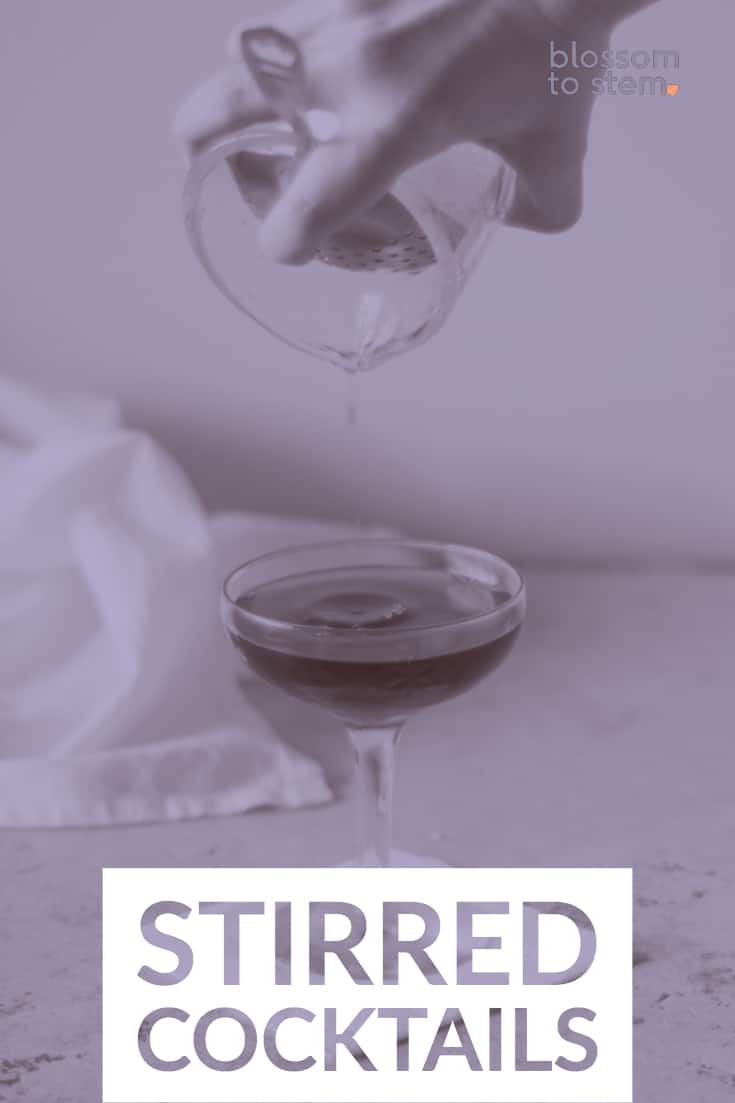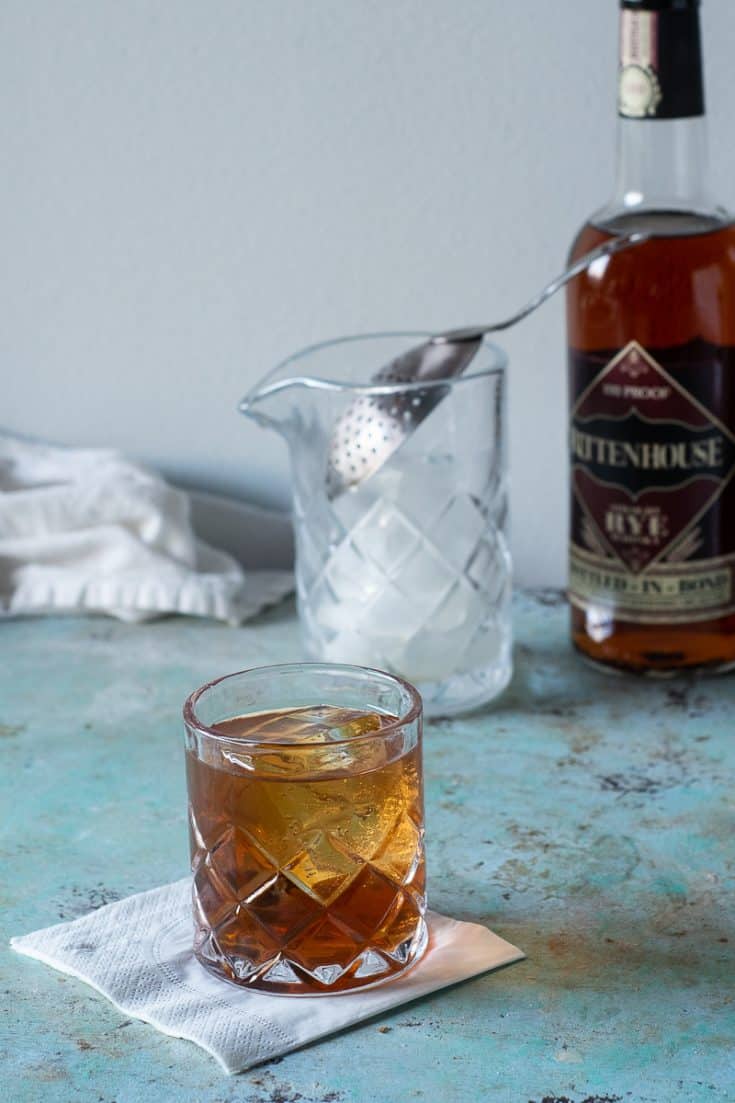I may earn from purchases through links in this post.
Are you a fan of crystal clear drinks? Ones that are smooth, often spirit-forward and tend to be served over a big ice cube or up? Then you, my friend, are looking for a stirred cocktail.
(If frothy drinks with citrus or egg white are more your style, take a look at my collection of shaken cocktails.)
You can use a sturdy pint glass for stirring a cocktail, or you can get a fancy mixing glass. The key is to have a something with a heavy bottom that won’t tip over easily.
Then you add any syrups and spirits and bitters you are using in your cocktail.
Then you add ice so that your glass is about 2/3 full.
Then you use a barspoon (it’s tough to do this with a standard spoon) to stir the drink until it is thoroughly chilled. This takes about 30 seconds of good stirring.
Then you strain the drink into a chilled cocktail glass, add any garnish you might be using, and serve.
Here I’ve gathered a great collection of stirred drinks. They include classics like the Sazerac and the Old Fashioned as well as less common drinks like the Revolver, which features bourbon and a coffee liqueur, and oddball drinks like the Popinjay, which uses the artichoke-based amaro Cynar (definitely not for everyone).

Stirred Cocktails
Cocktails for stirring with a bar spoon in a mixing glass. They tend to be spirit-forward and not rely heavily on citrus juices or egg whites. They might contain simple syrup (like any variation on the Old Fashioned). Stirring chills them without aerating the drink or adding ice chips, which produces a clear, smooth drink.
The Old Fashioned is really the original cocktail as it existed in the first half of the 19th century. If you're a purist, you can muddle a sugar cube with a teaspoon of water in lieu of using simple syrup here. In that case, serve the drink with a spoon, so you can stir the undissolved sugar. You can use bourbon or rye here, but bourbon is more common. Though I call for orange peel, lemon peel is also common. Feel free to use whichever you prefer.
The Vieux Carré spirit-forward New Orleanian take on the Manhattan. It's a richer, more complex drink than classic the Manhattan. The base is split between rye whiskey and cognac, and in addition to sweet vermouth there is a splash of Benedictine and dashes of Peychaud's and Angostura bitters.
The Negroni is a classic cocktail with equal parts gin, Campari, and sweet vermouth. It's a bracing, spirit-forward cocktail with notable bitterness from the Campari.
I like to use a Plymouth-style gin here, though a London Dry also works well. While I love the subtle botanical flavors in the crop of new wave craft gins, most of their subtleties would get lost here. Stick to something with straightforward juniper and citrus notes.
You can use any sweet vermouth you like. If you want it rich and sweet and heavy on the vanilla, go for Carpano Antica. But my go-to sweet vermouth for a Negroni is Cocchi di Torino.
There is no clear favorite for glassware on this one. It can be served in a coupe or a rocks glass or anything in between. Also, while I don't call for it here, this drink is sometimes served over ice. Feel free to do so if you prefer.
The Manhattan is a classic cocktail that features whiskey and sweet vermouth along with a few dashes of Angostura bitters. You can use either rye or bourbon, but I prefer rye for this. Look for a high proof whiskey for this. Rittenhouse, a 100 proof rye, is my go-to. My preferred sweet vermouth for this is Cocchi Vermouth di Torino. You can serve this up in a coupe glass with no ice, or as I have it pictured here, in a rocks glass with a big cube.
This riff on the Old Fashioned is made with Canadian whiskey or rye, but I think it’s better with rye. I like Old Overholt, which is pictured here, and is a reasonably priced old standby when it comes to rye, but this would be a nice place to show off a higher end rye if you have it. There are other Fernets out there, but I’ve only ever made this with the classic Fernet-Branca. If you want to get fancy, you can garnish this with a flamed orange twist.
"Dry" originally referred to making a Martini with dry rather than sweet vermouth, but has since come to mean a drink with a higher ratio of gin or vodka to dry vermouth.
I particularly like a gin Martini with Plymouth gin and Dolin dry vermouth, but any London dry or Plymouth style gin will work. For a vodka Martini, Absolut or Belvedere are good options, and again, I like them with Dolin.
This low-alcohol cocktail was originally developed by Stephen Cole at Chicago’s Violet Hour. It is on the bitter side of the spectrum, but it’s not an exceptionally bitter drink. It’s herbaceous and complex. The bitter Cynar gets held in check by the sweetness from the vermouth and the sour from the lemon juice. Sanders calls for Carpano Antica sweet vermouth, but lately I’ve been making it with Cocchi Vermouth di Torino. I think Vya sweet vermouth would also be lovely here. For the orange bitters, I recommend Regan’s Orange Bitters No. 6 or Angostura Orange Bitters over Fee Brothers (if you have some other less common orange bitters you like, feel free to use those).
This classic cocktail dates back to the turn of the 20th century. It’s a less-sweet variation on the famous Manhattan. The original version calls for Amer Picon, which is as of this writing is still unavailable in the U.S. and, regardless of availability, the modern stuff is very different from the original formula. There are plenty of potential substitutions, and if I were running a bar I would probably make a house version of Amer Picon, but my favorite workaround for home is simply the widely available Ramazzotti amaro and orange bitters. The proportions here are slightly different from the classic, but I like the balance.
This cocktail with Cynar, Cognac, and Punt e Mes, is a riff on a Boulevardier, which itself is a riff on a classic Negroni. The herbal, bitter Cynar gets tamed by the rich Cognac and the sweetness of the Punt e Mes. It's a simple equal-parts cocktail for fans of amari. I like to use Maison Rouge VS for an easy to find, reasonably priced mixing Cognac (there are plenty of better sipping Cognacs but they get pricey).
The Boulevardier is a variation on the Negroni with whiskey in place of gin (or alternately could be thought of a Manhattan with half of the sweet vermouth swapped out for Campari). It's a rich, bracing, spirit-forward cocktail. The original recipe called for equal parts whiskey, Campari, and sweet vermouth, and I still have a soft spot for that version, but most modern bartenders up the whiskey. This can be made with bourbon or rye (I prefer rye) and the sweet vermouth of your choice. Carpano Antica is always a good option, though my favorite version is made with Punt e Mes, a sweet vermouth with a bitter component for added complexity. You can express orange peel over the drink if you like. (I'm usually too lazy to bother with it for this one, but that's just me.) There is no clear favorite for glassware on this one. It can be served in a coupe or a rocks glass or anything in between. Also, while I don't call for it here, this drink is sometimes served over ice. Feel free to do so if you prefer.
The Sazerac is a classic New Orleans drink that was originally made with cognac, but is now typically made with rye whiskey. It's a bracing, spirit-forward drink for people who really love the taste of rye. It's a rinse of absinthe (you can also use Herbsaint), a mix of rye, simple syrup, and Peychaud's bitters, and a twist of lemon peel expressed over the glass. I like to use rich simple syrup here which is a 2:1 mix of sugar and water because it adds a little body to the drink. If you're a fan of cognac, you might try using half cognac and half rye for a nice, split-base variation. I like to use a rye on the lower-proof side (80-90) rather than one in the 100-proof range for the right balance in this one. (If all you have is a high proof whiskey, consider stirring it for a few more seconds to add some dilution to tame the heat.)
This cocktail is a regular one around these parts. It is a spirit-forward drink that’s perfectly balanced. Old Tom gin is making a comeback for a good reason. It’s sweeter and more full-bodied than the popular London dry style gins like Beefeater. This isn’t a place for Plymouth or Bombay Sapphire. I recommend Ransom Old Tom gin, an Oregon gin that is aged in pinot noir barrels, but I’ve had the drink made with Hayman’s Old Tom gin and enjoyed it that way as well. (Michigan’s Journeyman Distillery’s Bilberry Black Hearts Barrel Aged gin is not technically an Old Tom style, but the barrel-aging makes it work well in a drink like this.) Use any sweet vermouth you like. A big-flavored vermouth like Carpano Antica or Vya is especially lovely in this drink.
This is a great spirit forward winter cocktail. Calvados is also known as apple brandy, and nocino is a walnut liqueur.
I learned about this bourbon cocktail in Jeffrey Morgenthaler's excellent Bar Book. It comes from San Franciso bartender Jon Santer's time at Bourbon & Branch. It's a spirit forward cocktail for bourbon fans with subtle notes of coffee liqueur and garnished the oil from a flamed orange peel (which might be my favorite way to garnish a drink).














